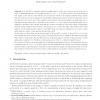Free Online Productivity Tools
i2Speak
i2Symbol
i2OCR
iTex2Img
iWeb2Print
iWeb2Shot
i2Type
iPdf2Split
iPdf2Merge
i2Bopomofo
i2Arabic
i2Style
i2Image
i2PDF
iLatex2Rtf
Sci2ools
JGT
2010
2010
Cubicity of interval graphs and the claw number
Let G(V, E) be a simple, undirected graph where V is the set of vertices and E is the set of edges. A b-dimensional cube is a Cartesian product I1 × I2 × · · · × Ib, where each Ii is a closed interval of unit length on the real line. The cubicity of G, denoted by cub(G) is the minimum positive integer b such that the vertices in G can be mapped to axis parallel b-dimensional cubes in such a way that two vertices are adjacent in G if and only if their assigned cubes intersect. An interval graph is a graph that can be represented as the intersection of intervals on the real line - i.e., the vertices of an interval graph can be mapped to intervals on the real line such that two vertices are adjacent if and only if their corresponding intervals overlap. Suppose S(m) denotes a star graph on m + 1 nodes. We define claw number ψ(G) of the graph to be the largest positive integer m such that S(m) is an induced subgraph of G. It can be easily shown that the cubicity of any graph is at l...
Cubes | Interval Graph | JGT 2010 | Real Line |
| Added | 28 Jan 2011 |
| Updated | 28 Jan 2011 |
| Type | Journal |
| Year | 2010 |
| Where | JGT |
| Authors | Abhijin Adiga, L. Sunil Chandran |
Comments (0)

